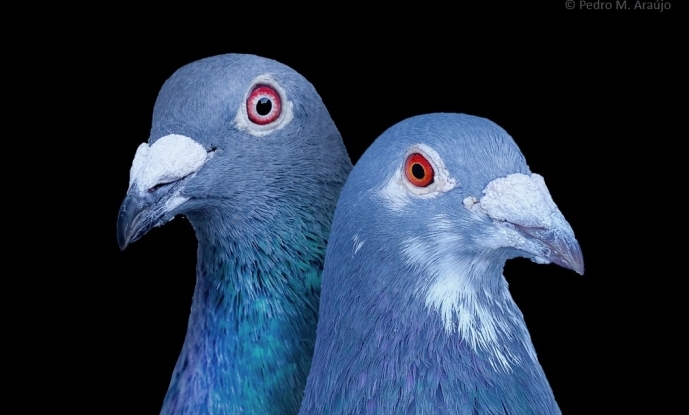A new paper by researchers from CIBIO-InBIO unveils the genetic basis of eye colour variation in pigeons

A study led by researchers from the EVOLGEN group provides the first description of a gene involved with eye pigmentation in birds and presents evidence for a developmental link between the iris of birds and the skin of ectothermic vertebrates.
Birds are among the most colorful of vertebrates, and their ornamental diversity has fascinated scientists and public alike for generations. A significant, but often overlooked, component of this diversity is eye coloration. Well known examples of this include the bright yellow eyes of glossy starlings, the dark ones of nocturnal raptors such as the barn owl, or even the striking (and aptly-named) red-eyed vireo. A fascinating aspect of eye coloration in birds is that the specialized cells in the iris that impart these hues seem to share many characteristics, not with the epidermal cells that generate colorful feathers, but rather with specialized pigment cells that are found in the skin of fish, amphibians and reptiles. This similarity has provoked debate among scientists, with some suggesting a shared developmental link between them, but support for this hypothesis has been lacking due to lack of conclusive evidence at the molecular level.
A new paper led by CIBIO researchers from the EVOLGEN group provides the first description of a gene involved with eye pigmentation in birds. This team took advantage of a unique model, the pearl-eye breed of domestic pigeons. In contrast with wild-type pigeons, which have pigmented yellow eyes, the iris of pearl-eye individuals is essentially white (unpigmented). This difference is caused by the lack of deposition of pterins, a class of pigments that is common in the skin of ectothermic vertebrates but is essentially absent in the hairs and feathers of endotherms. The gene that explains this difference in eye colour in pigeons, named SLC2A11B, had been previously implicated in variation in pigment cell development in fish skin, suggesting that the avian iris shares an evolutionary and developmental link with the pigment cells found in the integument of ectothermic vertebrates.
To access the full article please click here

